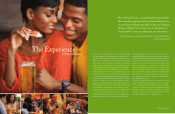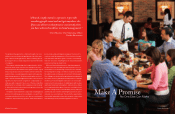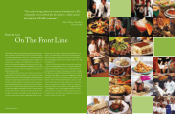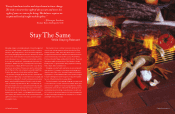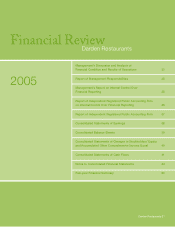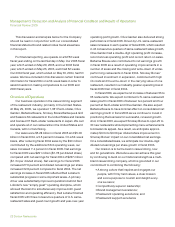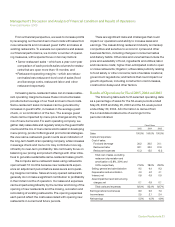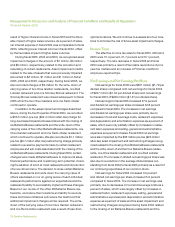Red Lobster 2005 Annual Report Download - page 8
Download and view the complete annual report
Please find page 8 of the 2005 Red Lobster annual report below. You can navigate through the pages in the report by either clicking on the pages listed below, or by using the keyword search tool below to find specific information within the annual report.
Managing change is a challenging dynamic in brand management
excellence. Rapid change to a brand can result in customer
alienation, and change that’s too slow can result in stagnation.
Successfully managing a brand in the face of behavioral, cultural
and economic shifts that affect consumer needs and tastes is
an evolutionary process – it happens incrementally over time.
As a company committed to creating brands that endure for
generations, Darden must stay constantly alert to these shifts
and respond accordingly. After 37 years in the casual dining
industry, we are veterans of this process, which is reflected by
the fact that we’re the only company in casual dining with two
$2 billion-plus brands in Red Lobster and Olive Garden.
The world has changed significantly since we opened the first
Red Lobster in 1968. Today, consumer tastes have changed and
broadened considerably. To meet this demand as Red Lobster
grew to more than 600 restaurants, Darden’s seafood supply
chain evolved into a global network. Also, consumers are cer-
tainly more health conscious now than they were 30 years ago.
So, while fried favorites will always have a place on the menu,
Red Lobster also offers a full range of fresh shellfish and fin fish
prepared in a variety of ways – including grilled and steamed.
The company also features lower-calorie, lower-fat items in the
LightHouse Selections section of its menu, and on its award-
winning kid’s menu.
Olive Garden’s story is similar. Consumers today are more
open to new culinary experiences than when the first Olive
Garden opened in 1982. That’s why Italian classics such as
Lasagna, Chicken Parmesan and Fettuccine Alfredo have been
joined on the menu by new favorites such as Pork Filettino,
Parmesan Crusted Tilapia and Ravioli di Portobello. These and
other menu additions remain true to Olive Garden’s culinary
brand promise – a genuine Italian dining experience featuring
fresh, simple, delicious Italian food.
Changing consumer habits and tastes also present growth
opportunities. For example, consumers are showing more
interest in wine. Wine is also a key part of a genuine Italian din-
ing experience. So Olive Garden built its wine selection program
to make ordering wine easier for guests. Today Olive Garden
has one of the best wine lists in casual dining.
The latest example of anticipating changing consumer needs
is our newest test concept, Seasons 52. Darden developed
Seasons 52 to capitalize on the increasing interest in healthy
and flavorful cuisine. As we continue the test, growing our four
existing brands and creating or acquiring new concepts, we
will continue our disciplined approach to brand management
excellence that helps Darden live its core purpose – to nourish
and delight everyone we serve.
While Staying Relevant
Stay The Same
Darden Restaurants 1312 Darden Restaurants
“ Every brand must evolve and stay relevant as times change.
e trick is to never lose sight of who you are and never lose
sight of your core reason for being. is balance requires an
exceptional level of insight and discipline.”
– JJ Buettgen, President
Smokey Bones Barbeque & Grill



